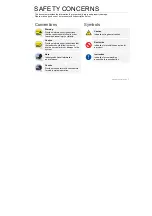
Appendix B: PC Serial Ports
Background
Serial ports (also sometimes referred to as communications ports or COM
ports) are hardware interfaces which permit your PC’s microprocessor to
communicate with peripheral devices using a communications standard called
RS-232 (hence, serial ports are also sometimes referred to as RS-232 ports).
Many common computer accessories make use of serial ports, including serial
mice, modems, serial printers, and the PassageWay adapter.
Under DOS (and Windows, which works cooperatively with DOS), the serial
port interfaces in a PC are uniquely identified by specific device names:
COM1 ("serial communications port 1"), COM2 ("serial communications port
2"), and so on, usually up through COM4. A particular PC might have none of
these devices, some of them, or all of them installed. For example, most PCs
currently on the market arrive from the manufacturer with two serial ports
already installed (COM1 and COM2), often integrated onto the computer's
main system board. Installing additional serial ports (for example, COM3 or
COM4) is usually accomplished by purchasing an add-on card and installing it
into a free expansion slot.
For most purposes (for example, configuring software), the generic description
of serial ports provided by their device names is sufficient. For example,
during the PassageWay Solution installation procedure, you are asked to
provide the device name of the serial port to which you have connected the
PassageWay adapter (for example, COM2). Unfortunately, this abstract view
of serial ports is not sufficient for other purposes, notably for troubleshooting
problems: to be able to do this effectively, a basic understanding of serial port
hardware is required. In particular, it’s essential to understand the mechanics
by which the computer’s microprocessor communicates with serial port
hardware.
B-2
The microprocessor/seriai port communication consists of two aspects: an I/O
port address and an interrupt request signal (IRQ). The I/O port address
Содержание Partner 18
Страница 1: ......
Страница 15: ...Contents C Appendix C Running AT TBuzz in Export via Paste Link DDE Mode C 1 Glossary GL 1 Index Index i x ...
Страница 21: ...xvi ...
Страница 28: ...Installing and Setting Up PassageWay Solution Figure 2 1 PassageWay Solution Components 2 3 ...
Страница 65: ...Installing and Setting Up PassageWay Solution 2 40 ...
Страница 93: ...Using AT TBuzz 3 28 ...
Страница 96: ...Using AT TCall Figure 4 1 Untitled AT TCall Window 4 3 ...
Страница 97: ...Using AT TCall Figure 4 2 Components of an AT TCall Window 4 4 ...
Страница 100: ...Using AT TCall Figure 4 4 Desktop with 10 20 Quick Dials and Card Hidden 4 7 ...
Страница 101: ...Using AT TCall Figure 4 5 Desktop with 25 50 Quick Dials and Card Displayed 4 8 ...
Страница 102: ...Using AT TCall Figure 4 6 Desktop with 25 50 Quick Dials and Card Hidden 4 9 ...
Страница 144: ...Using AT TCall Figure 4 26 Printed Cards With and Without the Notes 4 51 ...
Страница 177: ...Using AT TCall 4 84 ...
Страница 181: ...Using AT TSet Figure 5 2 Components of the AT TSet Window 5 4 ...
Страница 247: ...Using Log Viewer 6 20 ...
Страница 250: ...Using AT TConnect Figure 7 1 AT TConnect Window 7 3 ...
Страница 252: ...Using AT TConnect Figure 7 2 Events Log Dialog Box 2 When finished select the OK button 7 5 ...
Страница 265: ...Using AT TConnect 7 18 ...
Страница 287: ...Troubleshooting 9 18 ...
Страница 288: ...Appendix A Menu Trees This appendix contains the menu trees for the PassageWay applications A 1 ...
Страница 289: ...Appendix A Menu Trees Figure A 1 AT TBuzz Menu Tree A 2 ...
Страница 290: ...Appendix A Menu Trees Figure A 2 AT TCall Menu Tree A 3 ...
Страница 291: ...Appendix A Menu Trees Figure A 3 AT TSet Menu Tree A 4 ...
Страница 292: ...Appendix A Menu Trees Figure A 4 Log Viewer Menu Tree A 5 ...
Страница 293: ...Appendix A Menu Trees Figure A 5 AT TConnect Menu Tree A 6 ...
Страница 305: ...Appendix B PC Serial Ports B 12 ...
Страница 311: ...Glossary GL 4 ...
Страница 318: ...560 201 103 AT T 1993 AT T ...
















































